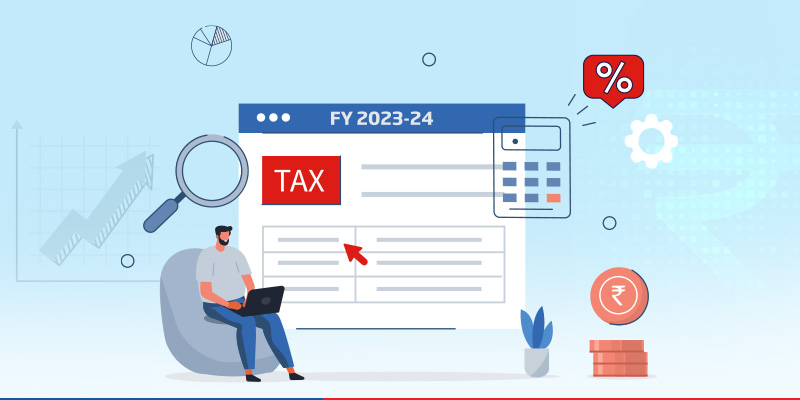
Check Credit Score for FREE
Instant in 2 Mins. No Impact on Credit Score

New Tax Regime FY 2025-26 (AY 2026-27): What Taxpayers Should Know?

From FY 2023-24, the new tax regime is proposed to be the default regime. The new tax regime is supposed to simplify the tax structure by offering lower tax rates, which makes it attractive for certain taxpayers; however, they are required to forego certain new tax deductions and exemptions to opt for the new regime.
Therefore, it is crucial for taxpayers to assess their finances including income from all the sources and tax-saving investments to make the most of the new tax regime.
Let’s look at the new tax regime rates and other changes in it for the financial year 2025-26.

Table of Contents

New Income Tax Regime Rates for FY 2025-26 (AY 2026-27)
The Union Budget 2025 proposed changes in the existing tax slabs of the new income tax regime, which are applicable from April 1, 2025, onwards. Here are the new tax rates:
Under this revised tax structure for FY 2025-26, individuals with earnings up to ₹12 lakh will not have to pay any tax thanks to an increased tax rebate of ₹60,000, under Section 87A.
What are the Changes in the New Tax Regime for FY 2025-26 (AY 2026-27)?
In addition to changes in the slabs in the new tax regime, Budget 2025 proposed some more changes in the rules for the new tax regime, which are as follows.
Note that apart from these changes, all other rules for the new tax regime remain the same as for FY 2024-25.
For Taxpayers up to 60 Years
- Income up to ₹12 lakh is now tax-free under the new tax regime.
- The basic exemption limit is hiked to ₹4 lakh from ₹3 lakh in the previous fiscal year.
- Salaried employees can now avail a rebate of ₹60,000 under Section 87A. Earlier this limit was ₹25,000.
- The Budget also provided a marginal relief benefit under Section 87A for incomes up to ₹12.75 lakh. It ensures that taxpayers whose income exceeds ₹12 lakh by a small margin do not have to pay significantly more tax.
For Taxpayers Above 60 Years
- The 2025 Budget doubled the tax deduction limit on interest income from ₹50,000 to ₹1 lakh.
- The TDS limit on fixed deposit interest has also been raised to ₹1 lakh annually.
- Now, withdrawals from National Savings Scheme (NSS) account after August 29, 2024, are from tax.
An Illustration Explaining Tax Free Income up to 12 Lakhs
Let’s understand how your income up to ₹12 lakhs can be tax-free with the help of an example:
Suppose your annual salary is ₹12,75,000.
Then,
- Standard Deduction: ₹75,000
- Taxable Income: ₹12,00,000
- Tax calculation as per new regime tax slab rates = ₹60,000
- Rebate u/s 87A: ₹60,000
- Total tax after rebate: ₹0
So, for an income of ₹12.75 lakh, the total tax payable under the new tax regime as per Budget 2025 is NIL.
New Income Tax Regime Rates for FY 2024-25 (AY 2025-26)
If you want to know the new tax slabs revised by Union Budget 2024, to plan and calculate your tax, check out the table below. These new tax slab rates are applicable for FY 2024-25.
What are the Existing Changes in the New Tax Regime for FY 2024-25 (AY 2025-26)?
For FY 2024-25, Budget 2024 changed the following things in the rules for the new tax regime:
- The standard deduction has been hiked to ₹75,000 starting from April 1, 2024. Earlier, the limit was ₹50,000.
- The standard deduction limit for family pensioners also hiked to ₹25,000 from ₹15,000.
- NPS contribution limit for private sector employees raised from 10% to 14% of their basic salary. So, now for both private and public sector employees, the deduction limit is 14%.
Tax Deductions and Exemptions Under New Tax Regime for FY 2025-26
The Union Budget 2025 altered a few income tax deductions and exemptions in the new tax regime. Here is a list of all the new tax deductions available under the new income tax regime that are allowed and not allowed for both financial years, i.e. FY 2024-25 and FY 2025-26.
Go through these options for tax deduction in the new tax regime to determine your tax liability.
Tax Deductions and Exemptions Allowed Under New Tax Regime
Tax Deductions and Exemptions Not Allowed Under New Tax Regime
As per the new tax regime rules, taxpayers opting for this income tax regime will have to forego up to 70 exemptions and deductions from the new tax regime in order to avail themselves of the benefits of the lowered new tax slab rates.
Some of the common tax deductions in the new tax regime that taxpayers cannot claim are:
How to Save Tax Under New Tax Regime?
Reducing tax liability while simultaneously achieving their financial goals is the main aim of every taxpayer as soon as the new fiscal year begins.
Since FY 2025-26 has revived most of the new tax regime deductions and benefits, the scope of tax saving under the new tax regime has become more limited than the old regime. So, here are some ways to save tax under the new regime:
- Invest in Tax-Efficient Options: Investing in options that offer tax-saving benefits along with low-risk returns should be every taxpayer’s priority. Check which instruments are available under the new regime and which are not before you start investing.
- Claim all the Deductions Possible: You can significantly lower your taxable income by utilizing all the relevant tax deductions allowed under the new tax regime, such as for home loans, etc.













